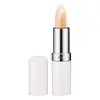What's inside
What's inside
 Key Ingredients
Key Ingredients

 Benefits
Benefits

 Concerns
Concerns

 Ingredients Side-by-side
Ingredients Side-by-side

Petrolatum
EmollientMyristyl Lactate
EmollientEthylhexyl Palmitate
EmollientRicinus Communis Seed Oil
MaskingOctyldodecanol
EmollientCandelilla Cera
EmollientCastor Oil/Ipdi Copolymer
Polybutene
Triisostearyl Citrate
EmollientPolyethylene
AbrasiveCera Alba
EmollientCopernicia Cerifera Cera
EmollientParfum
MaskingPhenoxyethanol
PreservativePolypropylene
Water
Skin ConditioningLinalool
PerfumingTocopherol
AntioxidantMica
Cosmetic ColorantIron Oxides
Petrolatum, Myristyl Lactate, Ethylhexyl Palmitate, Ricinus Communis Seed Oil, Octyldodecanol, Candelilla Cera, Castor Oil/Ipdi Copolymer, Polybutene, Triisostearyl Citrate, Polyethylene, Cera Alba, Copernicia Cerifera Cera, Parfum, Phenoxyethanol, Polypropylene, Water, Linalool, Tocopherol, Mica, Iron Oxides
Polybutene
Simmondsia Chinensis Seed Oil
EmollientPunica Granatum Sterols
Skin ConditioningDiisostearyl Malate
EmollientPolyethylene
AbrasiveC12-15 Alkyl Lactate
EmollientOctyldodecanol
EmollientIsostearyl Hydroxystearate
EmollientTriisostearyl Citrate
EmollientTrimethylolpropane Triisostearate
EmollientCandelilla Cera
EmollientTridecyl Trimellitate
EmollientEthylhexyl Palmitate
EmollientHydrogenated Polycyclopentadiene
Mentha Piperita Oil
MaskingPhenoxyethanol
PreservativeTribehenin
EmollientTetrahexyldecyl Ascorbate
AntioxidantTocopheryl Acetate
AntioxidantSorbitan Isostearate
EmulsifyingSilica Dimethyl Silylate
EmollientAstrocaryum Murumuru Seed Butter
EmollientTheobroma Grandiflorum Seed Butter
Skin ConditioningCocos Nucifera Oil
MaskingButylene Glycol
HumectantSodium Hyaluronate
HumectantAlgae Extract
EmollientLimonene
PerfumingLinalool
PerfumingGardenia Taitensis Flower Extract
Skin ConditioningTocopherol
AntioxidantPalmitoyl Tripeptide-1
Skin ConditioningCI 15850
Cosmetic ColorantCI 77891
Cosmetic ColorantCI 77491
Cosmetic ColorantPolybutene, Simmondsia Chinensis Seed Oil, Punica Granatum Sterols, Diisostearyl Malate, Polyethylene, C12-15 Alkyl Lactate, Octyldodecanol, Isostearyl Hydroxystearate, Triisostearyl Citrate, Trimethylolpropane Triisostearate, Candelilla Cera, Tridecyl Trimellitate, Ethylhexyl Palmitate, Hydrogenated Polycyclopentadiene, Mentha Piperita Oil, Phenoxyethanol, Tribehenin, Tetrahexyldecyl Ascorbate, Tocopheryl Acetate, Sorbitan Isostearate, Silica Dimethyl Silylate, Astrocaryum Murumuru Seed Butter, Theobroma Grandiflorum Seed Butter, Cocos Nucifera Oil, Butylene Glycol, Sodium Hyaluronate, Algae Extract, Limonene, Linalool, Gardenia Taitensis Flower Extract, Tocopherol, Palmitoyl Tripeptide-1, CI 15850, CI 77891, CI 77491
Ingredients Explained
These ingredients are found in both products.
Ingredients higher up in an ingredient list are typically present in a larger amount.
Candelilla Cera isn't fungal acne safe.
Ethylhexyl Palmitate, also known as octyl palmitate, is created from 2-ethylhexyl alcohol and palmitic acid. It is a fatty acid ester.
The fatty acid content of Ethylhexyl Palmitate makes it an emollient. Emollients help soften and hydrate your skin by trapping moisture within.
Ethylhexyl Palmitate is also used to help improve the texture of cosmetics. It helps other ingredient dissolve in products and help disperse ingredients more evenly.
You'll likely find this ingredient in sunscreen, as it is often used to mix UV-blocking ingredients such as avobenzone and ethylhexyl triazone.
It can also help stabilize the fragrances in a product as a fragrance fixative.
Ethylhexyl Palmitate can be used to substitute mineral oil.
Due to its high fatty acid content, it may not be fungal-acne safe.
Learn more about Ethylhexyl PalmitateLinalool is a fragrance and helps add scent to products. It's derived from common plants such as cinnamon, mint, citrus, and lavender.
Like Limonene, this ingredient oxidizes when exposed to air. Oxidized linalool can cause allergies and skin sensitivity.
This ingredient has a scent that is floral, spicy tropical, and citrus-like.
Learn more about LinaloolOctyldodecanol is a fatty alcohol. It is primarily used to enhance the texture of products.
As an emulsifier, Octyldodecanol helps prevent the oils and waters from separating. It also prevents ingredients from creating foam when shaken.
Octyldodecanol is created by reducing fatty acid to an alcohol.
Due to its high molecular weight, it does not get absorbed into the skin.
Learn more about OctyldodecanolPhenoxyethanol is a preservative that has germicide, antimicrobial, and aromatic properties. Studies show that phenoxyethanol can prevent microbial growth. By itself, it has a scent that is similar to that of a rose.
It's often used in formulations along with Caprylyl Glycol to preserve the shelf life of products.
Polybutene is used to help control the viscosity of a product. This just means it helps adjusts the texture.
It is a polymer and does not get absorbed into the skin due to its large size.
Studies found this ingredient did not irritate skin in concentrations below 15%.
Learn more about PolybutenePolyethylene is a synthetic ingredient that helps the skin retain moisture. It is a polymer.
It is also typically used within product formulations to help bind solid ingredients together and thicken oil-based ingredients. When added to balms and emulsions, it helps increase the melting point temperature.
Tocopherol (also known as Vitamin E) is a common antioxidant used to help protect the skin from free-radicals and strengthen the skin barrier. It's also fat soluble - this means our skin is great at absorbing it.
Vitamin E also helps keep your natural skin lipids healthy. Your lipid skin barrier naturally consists of lipids, ceramides, and fatty acids. Vitamin E offers extra protection for your skin’s lipid barrier, keeping your skin healthy and nourished.
Another benefit is a bit of UV protection. Vitamin E helps reduce the damage caused by UVB rays. (It should not replace your sunscreen). Combining it with Vitamin C can decrease sunburned cells and hyperpigmentation after UV exposure.
You might have noticed Vitamin E + C often paired together. This is because it is great at stabilizing Vitamin C. Using the two together helps increase the effectiveness of both ingredients.
There are often claims that Vitamin E can reduce/prevent scarring, but these claims haven't been confirmed by scientific research.
Learn more about TocopherolWe don't have a description for Triisostearyl Citrate yet.